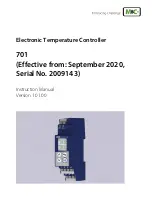
5
5.
Exit SETUP mode by putting the SETUP switch in the OFF/OPEN position (“operational” mode). The signals
should now operate properly. It may be necessary to repeat this procedure if layout lighting conditions change
significantly.
Note that the
Block Animator/2
will activate the sensor status LEDs when the associated sensor detects
a train in “operational” mode; this is different from the previous generation
Block Animator
!
Turning the pots clockwise adjusts for brighter overhead lighting conditions while turning the pots counter-clockwise adjusts
for dimmer overhead lighting.
Using Between-the-rails Infrared
The IR components should be mounted between the rails. Drill two 11/64” holes,
through the ballast, roadbed, and sub-roadbed. These holes should be located one tie
apart (Figure 7a) and drilled at a slight angle from vertical (see Figure 7b). The benefit of
mounting them at an angle is increased detection reliability in smaller scales or irregular
bottoms on rolling stock. For the smaller scales this drilling may end up hitting the ties.
Take your time so you do not mangle them! Insert the leads of one IR emitter (white and
black wires) into one of the holes (it does not matter which one!) from the top of your
layout. Repeat for the IR detector (blue and black wires).
The tops of the components
should sit no higher than the top of the ties for optimal IR performance;
in some
cases (e.g. false triggering) it may be necessary to locate the components a little below
the ballast line. You can extend the leads with similar (or larger) wire. We recommend
soldering and insulating these connections. We also recommend using terminal
blocks/strips since you will have multiple DC and GND connections to make. Once you
have wired the IR components and verified their operation you may wish to put a dab of
white glue or silicone caulk where the wires exit the holes underneath the layout. This
will help to hold the components in place; make sure you do not get any substance (e.g.
ballast or glue) on the top surface of the IR components as this may prevent them from
operating properly. In extreme cases where you may be getting interference from
overhead lighting you can mount the IR detector in some plastic or metal tubing. You
can also recess the IR detector slightly below the ties and roadbed.
Figure 7a
Figure 7b
Using Across-the-rails Infrared
With this sensor mode and physical arrangement a train is detected when the
infrared (IR) beam is broken by the train. The IR components should be located
across the track as shown in Figure 8a and 8b; the distance between them has
been tested up to 16 inches. The detectors (dark lens, blue and black wires)
should be mounted with a slight downward angle in order to minimize the
possibility of false triggering from visible light sources; this is illustrated in
Figure 8a. We would also recommend that you angle the emitters and detectors
across the track as shown in Figure 8b. This will minimize false “clear”
situations due to the space between rolling stock.
In the event the leads do not reach the circuit board you can extend them with
similar (or larger) wire. We recommend soldering these connections or using
terminal blocks/strips especially when you have multiple connections to make.
Aligning the IR components for reliable detection might be a bit challenging.
We recommend the use of a straight edge or ruler for initial “rough” alignment.
You can tweak the final alignment once you are ready to test the circuit.
Since the IR components are located trackside, you will probably want to
consider “hiding” them. There are numerous ways to do this such as using
shrubbery, small equipment buildings or fixtures. We leave this exercise up to
your imagination and creativity! We would strongly suggest that you get the
circuitry working properly first, and then address the physical appearance.
Figure 8a
Figure 8b
IR component wiring
Please note that the IR emitter wiring is DIFFERENT
from the previous generation
Block Animator
!
Figure 9 illustrates the wiring for ONE set of IR components (shown for sensor location “W1”). REPLICATE the same
wiring for the three remaining sensor inputs! Four 68 ohm ¼ watt resistors (Blue-Gray-Black color bands) are included with
the
Block Animator/2
.
NOTE: The four adjustment pots have NO affect when using either infrared sensor mode!
When
properly wired the emitters will have a very faint red glow. You can “see” the infrared light using your digital camera or
smartphone camera!
For safety reasons do NOT point the IR emitter directly into your eye or stare at the IR emitter!!!
STOP


























